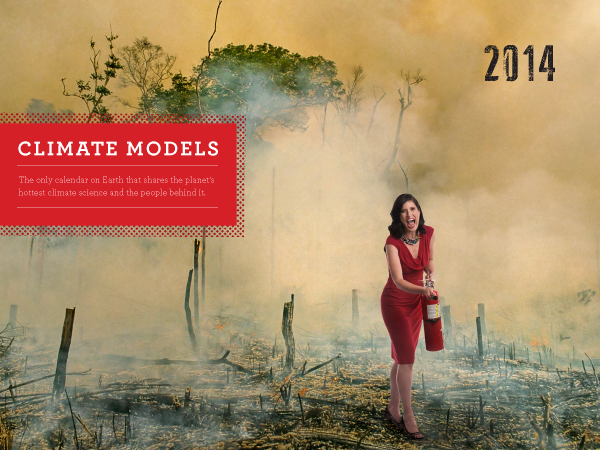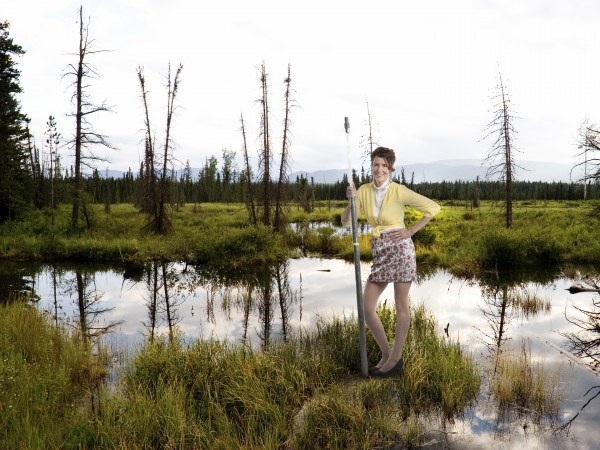7 April 2014
How climate modelers became calendar models
Posted by mcadams

Climate scientist Kátia Fernandes graces the cover of the 2014 Climate Models wall calendar. The punny calendar, imagined by two science writers at Columbia University, redefines what it means to be a climate ‘modeler’. Image credit: Charlie Naebeck.
By Francesco Fiondella and Rebecca Fowler
With some trepidation, we knocked on the first climate scientist’s door. Although we’re seasoned science writers at major research institutions, the request we were about to make was far different from our usual ones for interviews or images from field expeditions.
We had decided to create a 2014 Climate Models wall calendar, using climate scientists as models, in the belief that humor can be used to deliver serious messages in a less serious, but still meaningful way. Behind our idea was also a healthy (if not irrational) dose of confidence that others would find the ‘climate models’ pun as funny as we did.
Our list of candidates came from the institutions where we work: Lamont-Doherty Earth Observatory and the International Research Institute for Climate and Society (IRI), both part of Columbia University’s Earth Institute, as well as the NASA Goddard Institute for Space Studies. The researchers represented a broad scope of climate science, from paleoclimatology to numerical modeling, and were a balance of women and men, rising stars and established researchers.
Although we strategically chose the ever-friendly Nicolas Vigaud, an associate research scientist at IRI, as our first model candidate because we thought he’d say yes, we were still nervous as we approached him. We had to convince Nicolas and 12 other busy scientists to spend the better part of an August day in a photo shoot on the Lamont-Doherty campus, at the height of their fieldwork season.
To our delight, Nicolas said yes (sealing his fate as Dr. December) as did the next scientist and the one after that! We then modified our strategy to exploit the fact that we work with some fairly competitive people.
“No? Well, you know so-and-so has agreed to be in the calendar…”
In the end, only three scientists declined to participate, one due to a hectic travel schedule and two who said they just didn’t feel comfortable in front of a camera.
To watch our colleagues’ metamorphosis from research scientists to fashion models during the photo shoot was truly something to behold. Coordinating 13 scientists, two photographers, lighting, wardrobe, hair and makeup, and a bunch of other colleagues eager to sit in on the shoot took more effort than the search for Higgs Boson, but it was also one of the most enjoyable events of our careers.
- “Congratulations on a bizarrely interesting event,” Lamont-Doherty tree-ring scientist and research professor Brendan Buckley (Dr. November) said in an email the day after the photo shoot. “You guys pulled off one of the more interesting events I have ever seen at Lamont. I actually had fun participating, and watching the whole process.”
Luckily, photographers Jordan Matter and Charlie Naebeck had given us the skinny on how to organize a professional photo shoot and handle the post-production. We photographed the scientists in front of a white screen, since we couldn’t afford to travel the world for on-location shooting. Then we worked with each scientist to find a suitable background image that represented his or her field of research and merged it with their portrait. Together with Naebeck, we finalized the images and sent them to a designer, who put the entire calendar together.
In October 2013, we launched a Kickstarter crowdfunding campaign to raise money for the design and printing costs of the calendars. Using Kickstarter had the added benefit of promoting our calendar to an audience way beyond our own network. People who donated at least $25 received a calendar in return. A month after the campaign ended, the calendars were printed and on their way to walls around the world.
Almost immediately, the media mentions started rolling in. The calendar was featured by Grist, Climate Central, OnEarth Magazine (that site’s most viewed story in 2013), Live Science, Scientific American, The Weather Channel and others.
We were definitely surprised and very pleased by the amount of media attention the calendar received, but more so by its popularity both inside and outside the scientific community.
“Thank you so much for the climate calendar! I will definitely be using the information and research mentioned as a supplement to my climate unit in Earth science later this year,” said Joanna Morabito, a science teacher at Irvington High School in New York.

“My feeling is that scientists need all the help they can get in terms of getting their message out, and [the calendar] was a very different and creative way to show climate science,” said Lamont-Doherty senior research scientist and model Dorothy Peteet (Dr. October), pictured above. Image credit: Charlie Naebeck.
One reason we think our project was successful is that it shared climate science in a way that didn’t focus only on facts or heavily feature gloom-and-doom. The project also succeeded because it had support from our institutions and buy-in from the scientists who participated. They took a leap of faith, believing as we did that the calendar would resonate with teachers, students and other non-scientists.
Will there be a 2015 Climate Models calendar? Many people want to know—including us. We intend to continue pushing the science communication envelope and are currently brainstorming ideas for our next project, which may be another calendar…or something completely different.
Science communication is a field that offers a lot of room to experiment and we’d like to begin a dialogue with other science writers and scientists about novel and effective ways to share science. Let us know what you think!
Initial funding for this project came from the Robert Rauschenberg Foundation, which awarded us a small grant, and the New York City chapter of the Awesome Foundation, which shared our belief that a calendar of climate scientist models could be, well, awesome.
– Francesco Fiondella [[email protected]] communicates science for The International Research Institute for Climate and Society; Rebecca Fowler [[email protected]] tells stories about the research happening at Lamont-Doherty Earth Observatory. Follow them on Twitter @fiondella and @by_rebecca.


 The Plainspoken Scientist is the science communication blog of AGU’s Sharing Science program. With this blog, we wish to showcase creative and effective science communication via multiple mediums and modes.
The Plainspoken Scientist is the science communication blog of AGU’s Sharing Science program. With this blog, we wish to showcase creative and effective science communication via multiple mediums and modes.
great start ……………..
This is really nice and I find this very much appropriate and this will easily alert people on climate related issues. This is kind of coming to the public forum with your high-end science.
Loved my 2014 calendar. There does not seem to be a 2015 one though. Where will I get my nerdy modeling puns?